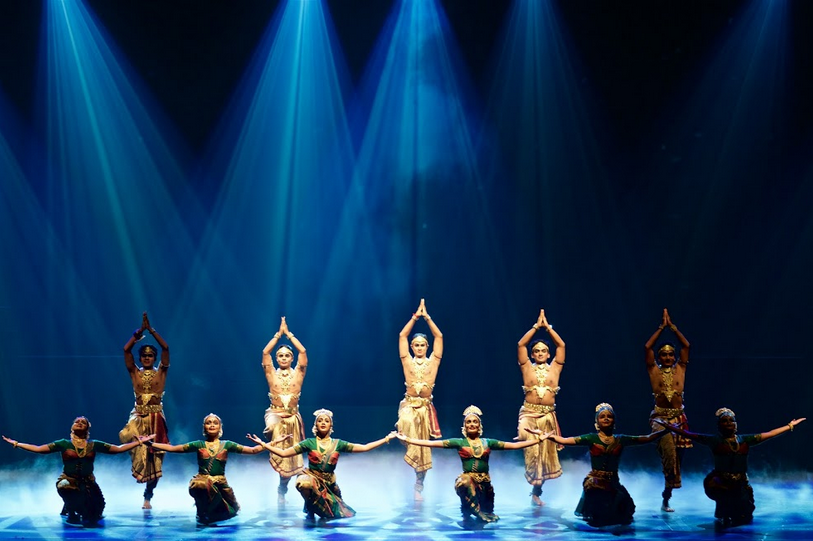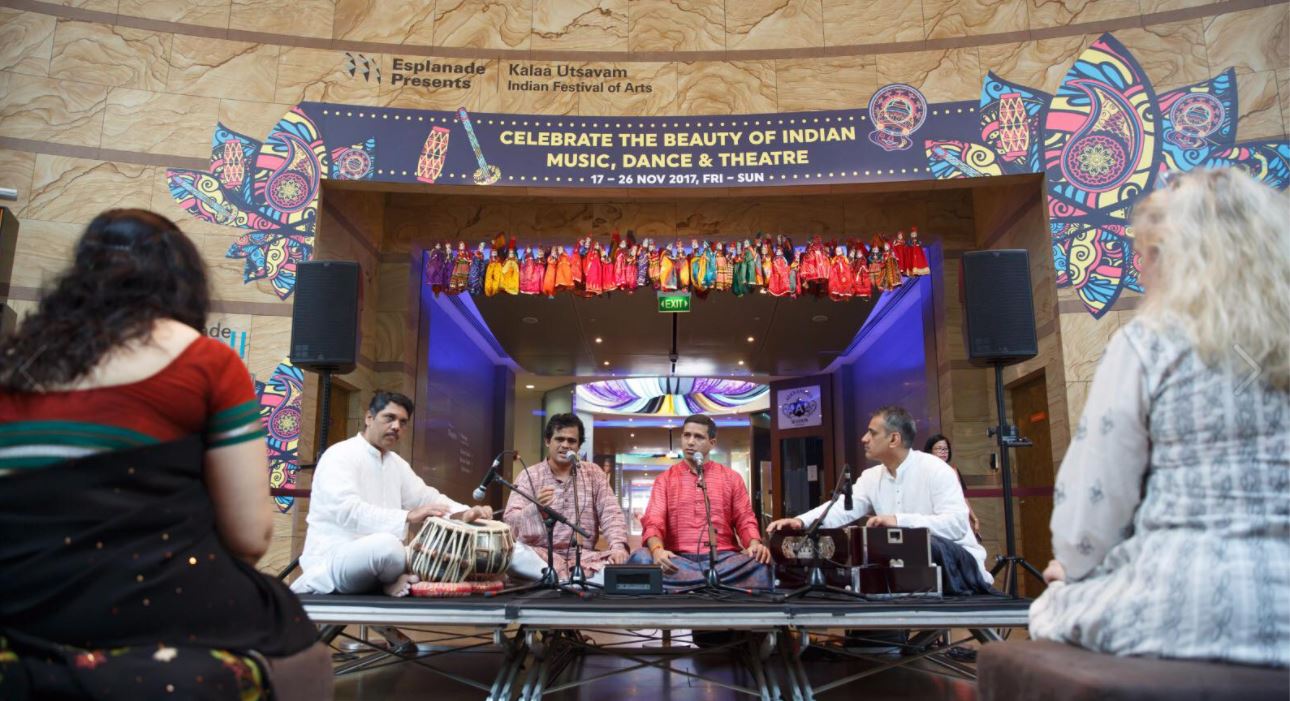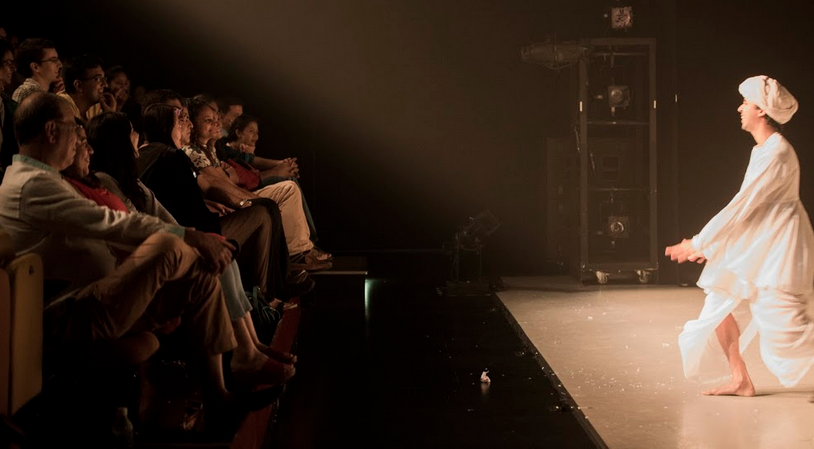What does it take for a festival like Kalaa Utsavam to happen? How does one plan for a ten day festival that this year has about 200 artists performing? What has changed since the first Kalaa Utsavam in 2002? How does the team make it different year after year? These are questions that are bound to cross your mind when you attend the annual feast of Indian culture in Singapore. Connected to India met the team that puts the festival together to find some answers.
It is past 10pm on a week night. The festival is due to open the next evening- less than 24 hours to the opening of the ten day festival. Rehearsal of the inaugural show is underway. It will be atleast another hour before it is done. Back stage is a flurry of activity. Performers with elaborate make up and costumes move in and out. Those outside track the on-goings on stage through a monitor waiting for cue to enter. The Producer of the festival, Rajeswari Ramchandran moves around briskly answering questions, giving instructions and overseeing a sheet of paper that lists performers of the show. Her ears are keenly listening to the list being read out to correct any mispronunciation. Sai Akileshwar, a Programmer of the festival is ensuring that all associated paperwork is taken care off. Discreet and firm, they both look happily tired.
The Kalaa Utsavam team consists of four people. Programmers, David Pandarakannu, Shridar Mani, Sai Akileshwar and Producer Rajeswari Ramachandran. The objective is to make the annual celebration of Indian arts and culture different year after year.
Rajeswari says the festival has evolved in the selections and range of programs since the first one in 2002. Shridar Mani points out two aspects of the festival that have evolved most, are the breadth and quality of the free programmes that are offered over the 10 days, as well as the new works by local artists and arts groups presented at the festival. These two aspects, he says, are a testament to the impact the festival and Esplanade have had on the development of the local performing arts scene in Singapore. Akileshwar shares that an important exercise is to assess how the festival serves the community rather than remain one just for consumption. The main goal is to make the festival as inviting and inclusive as possible.
The team works very hard to offer many points of entry for audiences of different level of arts appreciation and for Indians and non-Indians. Planning for the festival begins more than a year in advance. It is critical to lock in dates with artists for the festival. David Pandarakannu ensures that all administrative things such as contract, logistics etc. are sorted out. He makes sure that all publicity materials are submitted on time for collaterals and he connects artists with the production team for technical requirements.
It helps that team members are artists themselves. Rajeswari is a Bharatnatyam dancer (started learning at the age of four) and a violinist (started learning at the age of eight). She has been a part of the Singapore Indian Orchestra and Choir for about 14 years. Similarly, Akileshwar has been learning, practicing and performing on the mridangam for about 25 years. After doing his Arangetram in 2002 and finishing national service in 2007 he got a Diploma in mridangam in the year 2010. “My guru Mr T R Sundaresan is one of the main reasons to why I took it up as full-time profession from the year 2013-2015. Before that I received the National Arts Council’s post-graduate scholarship to pursue a Masters in mridangam in Chennai. Since joining Esplanade, I try to practice for an hour every day so that I don’t lose touch,” he says.
So what impact has art had in the personal lives of these team members?
“It is an aspect in me that has made me who I am today. I was introduced to the arts by my father and I believe it’s an essential part of being human,” says Rajeswari.
“Learning an instrument teaches one discipline and hard work. And to be linked to the arts as a profession is definitely a blessing. Working at Esplanade exposed me to a different dimension of viewing it.” believes Akileshwar
Shridar says, “The practice of art is in many ways a mirror that we hold up to ourselves. It is ironic that the art of performance confers upon us a certain degree of truth and self-awareness that the performance of our daily lives does not. In art, there is no room for pretension and this allows us to always reflect upon the world that we.”
The first day is a day of mixed emotions. Stress can be high during the ten days of the festival. There are often been last minute changes and requests that the team needs to take quick decisions on. David recalls during a festival in the past, an artist became unwell about an hour before the show and they had to make some important decisions as to whether they carry on without her or not. He says, “Thankfully, the audience was gracious enough to understand and accept some of the eventual changes we had to make to the show.” Shridar says, “Beyond offering a respite from the drudgery of our daily routines, the arts allow us to reflect more deeply on our own human nature; on the conditions and preconditions that allow us to observe, feel and connect. Whether it is Carnatic music, ritual theatre or contemporary dance-theatre, all art forms give us the opportunity to think about our connections with others and our understanding of ourselves.
Art is subjective. So how do you gauge if the festival was a success or not?
Akileshwar puts success in perspective. “It is very difficult to quantify success in the arts industry. Good ticket sales are always heartening but that’s not all that we look at. We do this for the audience, their reaction matters the most. What we look at is whether we have inspired artists or organisations to better their game or to take the next step.”
True. Inspiring is empowering. It is also the highest level of success one can have.





